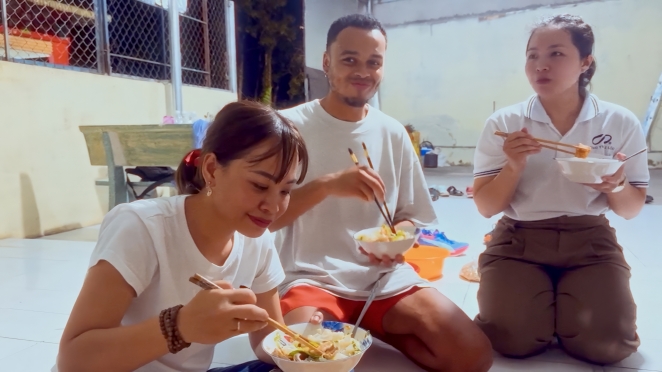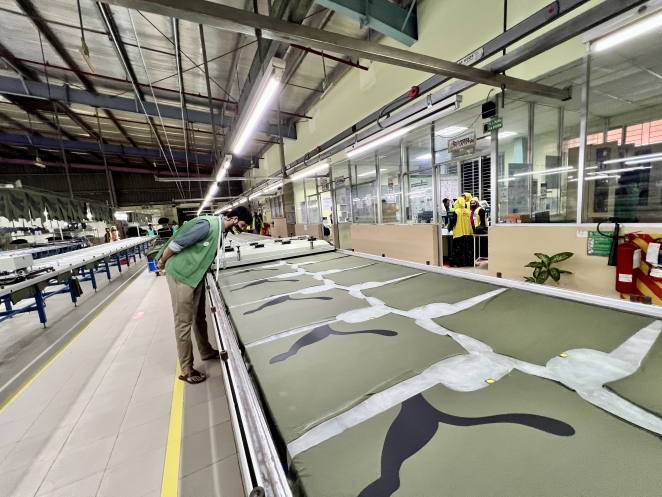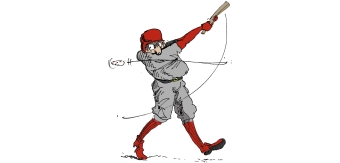This week, we sit down with Michael Crosbie, Associate Creative Director at MSL, to discuss PUMA's Voices of a RE:GENERATION initiative, launched in April 2023. This innovative program engages four Gen-Z voices in PUMA's sustainability practices, aiming to connect with the next generation on meaningful environmental issues.
Throughout 2023, three of these voices, Luke Jaque-Rodney, Jade Roche, and Andrew Burgess, visited PUMA's manufacturing partners to understand the complexities of sustainability at scale.
They captured and shared unfiltered footage of their experiences, providing new perspectives and suggesting improvements to PUMA's sustainability efforts. Anne-Laure Descours, PUMA's Chief Sourcing Officer, emphasized the importance of involving younger generations in sustainability decisions to showcase the genuine progress and challenges faced in the supply chain.
The video series created by these voices highlights various social and environmental aspects of the garment industry, including working conditions, fair wages, textile waste, and resource efficiency.
Luke, Jade, and Andrew's visits to factories in Bangladesh, Vietnam, and Turkey offered insights into production processes and engaged directly with factory owners and workers. Their films, available on social media and PUMA's online platforms, aim to reshape perceptions of the garment industry through visual storytelling.
Today, this interview with Michael Crosbie provides an in-depth look at how PUMA's initiative is driving forward sustainability education and transparency.
What was the brief?
First a bit of background might be helpful:
PUMA is a recognised world leader in sustainability. It completed its first environmental P&L audit in 2011, valuing its impacts at $145m. The business made sustainability a core pillar of its brand.
Sustainability isn't just a boardroom buzzword – it's the battle cry of the next generation. Today's young people are demanding a say in their future, craving connection with brands that can shape a more sustainable world.
Yet, 71% feel unheard and overlooked in the sustainability conversation. Two in five wish they could connect with brands to help chart a better course,
In 2022, we hosted Conference of the People, a day powered by PUMA, which brought together influencers, industry experts, and NGOs to talk about challenges, progress and connect with a younger audience.
Instead, what the next generation told us was that sustainability, as it is talked about today, isn’t engaging. It isn’t accessible. It isn’t transparent in a way which they recognise.
In 2023, we hit that critique head on by launching Voices of a RE:GENERATION. A cohort of passionate, committed young people from across the globe, working hand-in-hand with PUMA to co-create a world that's not just sustainable, but thriving for all.
This is more than a campaign. It's an ongoing commitment to drive real change, authentic education, and empowerment for the next generation of change-makers.
So now to answer the question about the brief: Luke Jaque-Rodney, one of the Voices of a RE:GENERATION, is a nutritionist, author and influencer based in Germany. PUMA offered Luke and MSL the opportunity to travel with them to Bangladesh and Vietnam to witness their supply chain first hand. And to communicate what they saw to his audience (and PUMA’s) to challenge perceptions that people might have.
How did the initial pitch/brainstorming phase go?
When we started the brainstorming phase, we kept in mind that Voices of a RE:GENERATION is an influencer-led initiative.
Our primary approach was to provide Luke with a brief that he could interpret in his own way. His initial response was less of a concrete idea and those first conversations with him were more of a deep dive into his audience, what he is passionate about in the here and now, and his personal projects outside of the PUMA partnership.
Of note, Luke's audience deeply appreciates his soft tone and authentic nature of his content – he's not bombastic. This has earned him their deep trust. At the time, he was on the verge of launching his own cookbook. This gave us a substantial amount of food for thought (sorry for the pun) and served as a springboard for our concept development.
What was the process behind ideating the concept?
Influencers, like Luke, generally focus on their own channels and audiences. They have a deep understanding of what their followers want to see and what fits within their existing content. But we approached the concept keeping PUMA's communication goals in mind, along with a solid understanding of what hits the right notes with various stakeholders who aren't our direct clients, like the social team, teamsport, and the sustainability team.
Instead of working on concepts alone, we held a number of workshops to bridge the gap between these two viewpoints. The result was our final concept - "Stitch & Spice," a series of five Instagram Reels.
This concept smartly weaved together Luke's (and his audience’s) love for wholesome and tasty food with stories of workers in PUMA's supply chain. The heart of this concept was Luke's belief that food is a universal language that helps us connect, going beyond cultural, religious, and social differences.
In each episode, Luke would have a meal with different types of workers (like union workers, female workers, siblings, and factory management). We filmed these insightful conversations, spent time with them in the factory, and put the episodes together.
This format was true to Luke's brand and in line with PUMA's goals of showing the progress and challenges of sustainability at a large scale in a transparent manner.
What was the production process like?
Heading into the factory was a whirlwind. For those of us who aren't in the shoe or clothing industry, understanding what a factory setting is like feels next to impossible. Despite plenty of reading and consulting with NGOs, auditors, and factory staff, the reality still hit us hard - it is a world away from what we're used to.
With the budget being tight, my colleague Natasha Torres-Cootes and I had to wear many hats - we were the film crew, influencer managers, client liaisons and journalists .We geared up with filming tools - gimbals, sound equipment, hard drives, tripods, headphones - and even took some online courses to prep. To keep it real and because it was good enough for social media, we filmed everything on iPhones.
I'm no stranger to being behind the camera, but this was the first time I was filming, directing, and handling sound all at once. And the schedule was packed - sometimes two factories in a day, followed by dinners and interviews.
Even the travel was intense, with up to five hours to cover short distances, and we often needed police escorts. Our bus was our mini production hub - for data wrangling, charging equipment, the works. The term ‘relentless positivity’ was bantered around a lot.
In a nutshell, it was a lot to take in. A culture shock, a steep learning curve, and a test of our preparedness. We were ready, but we couldn't fully anticipate what awaited us.
What was the biggest challenge during production? How did you overcome it?
Just as we were beginning to plan this trip, Shein conducted their own. They took a group of influencers who regularly promoted Shein products to see their 'supply chain' first hand. However, they didn't actually show them their real supply chain. Instead, they took them to an innovation centre. The whole trip was completely devoid of authenticity. At that time, I posted an article about my thoughts on green-washing vs green-hushing and the impact of Shein's trip.

But this was a real wakeup call for us. We knew that our trip had to be impartial and factual. The factories we visited had to be the real deal, warts and all. We made it absolutely clear to the factories that they had to operate as they regularly do. Workers weren't allowed to be coached on what to say.
We had independent translators and everyone on the trip was allowed to talk to any worker they wished. Not only that, we set up calls with NGOs to allow us to understand how auditing works, how unionisation works, how pay works – all from independent third parties.
What kit/tools/software were used to create the project?
During production – two Zhiyun Smooth S5 gimbals, two DJI dual mic packs, an iPhone 13 Pro and an iPhone 15 Pro Max, a lot of power banks and hard drives.
In post production we used Adobe Creative Suite.
What is one funny or notable thing that happened during production?
We were on the bus. We had spent the day at Dai Loc Shoe Corporation, one of PUMA’s core footwear suppliers. And we’d spent the evening at the home of Diệu and Luyến, two workers and siblings from the factory.
Sweltering hot, we had completed the interview in their small kitchen while prepping the food on the floor. Dripping in sweat we ate the most delicious meal of our lives. Prepared with nothing more than a couple of knives, a double camp stovetop and a tap, and some incredible people.
Exhausted but with a long journey back to the hotel we started to do the data wrangling. And it was at this point that we realised that we had around 800GB of footage on the hard drive. Keep in mind that's iPhone 4k footage, not RAW.

It was at that moment that my colleague Natasha, turned to me and joked that we should make this into a feature length film. It was a joke at the time, but as the hard drive got closer to running out of space, the more that we privately contemplated turning this into a documentary. We knew that we hadn't shot for a documentary. We had shot for 1.5min Instagram reels episodes.
When we got back to London we had a challenge – selling a bigger idea to the client and to our agency (because inevitably it would require investment), and how the hell we were going to weave all of these stories into a documentary that would be worth watching. The pay off was that this was going to allow us to tell a more compelling story to media and create a substantial piece of creativity that could be entered into film festivals.
One of the things I love about working in an agency and working with a bold and brave client is you get to try things you've never done before. We assembled an in-house team which included our video editor, our Head of Content and Copy Emily Fleuriot, accounts teams, and Luke to first unravel everything we had captured, and we pieced it back together again.
What became clear as we were going through was that we needed to create a red thread and impartiality. Brooke Roberts-Islam, a Senior Contributor at Forbes, travelled with us on the trip. A conversation between her and Luke became what guided people through the documentary.
Another challenge that this posed was that we needed to rethink what Luke was going to be posting. As well as creating a trailer that sat on PUMA and Luke’s channels, he created a series of behind the scenes content – from insights into how he prepared for the trip, to nuggets of information he learnt along the way, to cooking tutorials from meals he ate while over there. All pointing back to the main doco.
What’s the main message of this project and why does it matter?
"Stitch & Spice" captures the essence of workers' narratives, using the universal appeal of food to bridge cultural divides, highlighting our shared human experiences. The film draws a link between these personal stories and wider consumer habits, challenging viewers to think about the consequences of their fashion choices.
It provides an insight into sustainability from a relatable, human angle, shedding light on the efforts of governments, businesses, and others to create a sustainable future. The film offers a peek into the lives of those impacted, revealing their dreams, daily hurdles, and experiences of change. It's designed to pique curiosity, prompting viewers to question and critically engage with the subject.

The critical need for communicating this message is highlighted by the worrying trend of fast fashion and rampant consumerism. "Stitch & Spice" serves as a reflection on these issues, urging viewers to think about the environmental and human impact of their shopping habits, especially in a culture that promotes disposable fashion trends at the cost of sustainability and ethical practices.
How long did it take from inception to delivery?
July 2023 – April 2024
Can you describe the creative spark or inspiration behind the initial concept? Was there a specific moment or insight that ignited the idea?
The creative spark for this project came from Luke talking about how he loves sharing food and learning about others' stories through it. He referred to food as a great connector, which inspired us to use this universal language as a means of bridging cultural divides and highlighting our shared human experiences.
How did you ensure that the concept aligned with the brand's values, goals, and target audience?
Transparency was at the heart of what PUMA wanted to achieve with this venture. They boldly decided to lay their supply chain bare for all to see. It was like pulling back the curtain for our audience, revealing the real-world processes behind the products they buy.
We went all out to ensure this transparency was genuine and thorough. We visited the actual factories where the magic happens, no stage-managing, no rehearsed lines. We made sure workers could freely express themselves, with independent translators on hand to keep things fair and square. We gave these hardworking individuals a platform to tell their own stories, allowing our audience to hear straight from the horse's mouth.
We also joined forces with NGOs to delve deeper into the ins and outs of factory auditing, unionisation, and wage structures. This gave us a broad and factual perspective of what goes on within PUMA's supply chain.
In a nutshell, PUMA's commitment to transparency and sustainability was front and centre throughout this project. They've pushed the boundaries, raising the bar for openness in the industry.
What role did consumer research or market analysis play in shaping the concept and its execution?
Working with PUMA, especially in the area of sustainability, has been quite a journey. Over time, we've developed a deep understanding of their audience and what clicks with them. We've also recognised the significance of being transparent and genuine when talking about sustainability efforts.

The Shein incident was a real eye-opener. It served as a stark warning about the risks of not being authentic and the potential fallout from a dishonest approach. We took this lesson to heart and it played a pivotal role in planning and executing our project.
Also, we relied heavily on Luke's deep connection with his audience. His daily interactions with his followers have given him a unique insight into what matters to them, what gets their attention, and how they view different subjects. This insight was invaluable in shaping the concept and execution of our project, ensuring we resonated with his audience while staying true to PUMA's brand values and sustainability goals.
Can you discuss any unique or unconventional production techniques or approaches used to bring the idea to life?
Creating this documentary was a whole new ball game. Unintentionally, we had ditched the usual way of doing things – no big film crew, no detailed location scouting, no dedicated research team. Instead, my colleague and I turned into a two-person show, juggling multiple roles and learning as we went along.
This gave the documentary a raw and real feel. We grappled with the challenges of filming in a completely new environment, managed the influencer, coordinated with the client and journalists, and took care of the nitty-gritty of filming, all the while immersing ourselves in the alien world of the factory setting.
This hands-on, dive-in-head-first approach was certainly tough, but it helped us keep an authentic perspective and ensured that the final product was a true reflection of what we saw and experienced.
How did you ensure that the concept remained innovative and stood out in a crowded marketplace?
PUMA's decision to be so open really sets them apart. A lot of brands would see this as too risky and revealing. But, PUMA's bold move to let the public see their supply chain shows a unique dedication to transparency and sustainability. This fresh take on transparency and sustainability isn't something you usually see in the industry, and that's why the project really stands out.
What do you hope it achieves for the brand?
Transparency and authenticity. In a way that people recognise.
Credit list for the work?
Creative Director – Michael Crosbie
Content Director – Emily Fleuriot
Editors – Ben Williams, Ardi Maxhuni
Executive Producers – Anne-Laure Descours, Veronique Rochet, Kerstin Neuber, Samantha Du Plessis
Producers – Michael Dowell, Jess Gross
Production Coordinator – Natasha Torres-Coote
Project Coordinators – Hayley Ticehurst, Charlotte Bottrill
NARRATED BY
Luke Jaque-Rodney
Brooke Roberts-Islam
BANGLADESH PRODUCTION TEAM
COORDINATORS
Moyeen Hyder Chowdhury
Sadia Sharmin
INDEPENDENT TRANSLATORS
Shohan Mohammed Wasiuzzaman Medha Zayan
Zakia Haque
VIETNAM PRODUCTION TEAM
COORDINATORS
Annie Phan
Chinh Nguyen
INDEPENDENT TRANSLATORS
Duong Thuy Nguyen
Lê Thị Nguyên Thảo
PARTICIPANTS FROM BANGLADESH
Forida Khatun
Mohammed Abdul Quader Anu
Syeda Eli Akter
Nur Jahan
Adhara Akter
Shathi Khatun
Tamima Chowdhury
PARTICIPANTS FROM VIETNAM
Nguyễn Xuân Diệu
Nguyễn Thị Luyến
Trần Ngọc Liên
Thái Văn Thanh
Lê Thị Thúy Hằng
Nguyễn Anh Thư
PUMA SUPPLIERS
Jinnat Knitwears Ltd (DBL Group)
Hamza Textiles Ltd (DBL Group)
Fakhruddin Textile Mills Ltd (Urmi Group)
Dai Loc Shoe Corporation
Alliance One Apparel Co. Ltd.
PUMA PARTNERS
Better Work
Amader Kotha Helpline
Apparel Impact Institute
UNFCCC
IFC Pact (Bangladesh)





